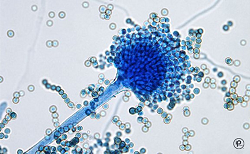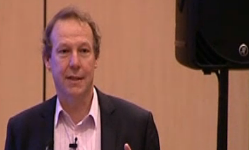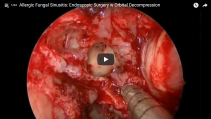Lecture Overview
In his first lecture, Dustin explains that adaptive immunity allows an individual to specifically recognize and respond to a vast number of molecules. B cells recognize intact antigens and produce neutralizing antibodies. T cells, on the other hand, have receptors on their surface that recognize very small antigen fragments bound to MHC on the surface of antigen presenting cells (APC). Dustin explains that T cells overcome the challenges of finding and binding to the APCs with the help of a multitude of adhesion molecules. Once the T cell receptor has bound a peptide antigen, an immunological synapse, with its typical bulls-eye structure, is formed resulting in T cell activation.
In Part 2, Dustin describes how a reconstituted system has allowed the immunological synapse to be studied in molecular detail. It is possible to visualize the localization of signaling molecules such as kinases, and determine the role of the actin cytoskeleton in regulating this localization. Dustin also touches on the role of the immunological synapse in autoimmune disease and cancer.
In his last lecture, Dustin presents work from his lab showing that T cell receptor enriched vesicles are generated in the immunological synapse. These vesicles can be transferred to B cells leading to activation of the B cells and, potentially, the production of higher specificity antibodies.
Speaker Bio
Michael Dustin is Professor of Immunology and Director of Research at The Kennedy Institute of Rheumatology at the University of Oxford. Prior to joining the Kennedy Institute, Dustin was a faculty member at the Skirball Institute of Biomolecular Medicine at New York University from 2001-2013 and at Washington University School of Medicine from 1993-2000. Dustin received his BA in Biology from Boston University and his PhD in Cell and Developmental Biology from Harvard University.
As described in his iBioSeminar, Dustin’s lab studies the molecular events that take place at the immunological synapse. Future research will focus on developing therapies targeted to the immunological synapse to cure chronic inflammatory illnesses such as rheumatoid arthritis.
Dustin is an active participant in the immunology community; he is a member of numerous grant review committees and journal editorial boards. His research has been recognized with many awards including the 2000 Presidential Early Career Award in Science and Engineering and the 2012 DART-NYU Biotechnology Achievement Award.
Medical and Patient education videos
-
Title
Description
-

Kindly provided by Dr Ronan O’Driscoll and with thanks to Dr P Barber, Bronchoscopy Unit, Wythenshawe Hospital, Manchester. Copyright Dr R. O’Driscoll.
-

This talk on CPA was delivered by Professor David Denning to clinicians and laboratory scientists in Ghana on February 1st 2019, World Aspergillosis Day.
-

Although people usually relate fungi with diseases, Dr. Anne Pringle provides an overview of the vastly diverse and complex world of fungi, and provides examples of the beneficial roles that fungi have on Earth. For example, although some fungi have been associated with devastating infections that threaten harvests every year, other fungi are mutualists needed for the healthy development of plants and animals.
In her second lecture, Pringle explains how one can use a “reverse ecology” approach to describe and characterize different organisms and their habitats, by studying their genes. Her laboratory used this approach to study the origins of the Bay Area Amanita phalloides. Although Amanita phalloides was thought to be an invasive species, historical records were mostly descriptive and hard to use as concrete evidence of the species’ biogeography. Using genetic information, the Pringle laboratory was able to definitively prove that early samples identified as Amanita phalloides in the US are distinct from the European species. They also used molecular data to document the symbiotic associations between Amanita phalloides and plants, proving the efficacy of these approaches to study species that are hard to grow in the lab.
In her third lecture, Pringle provides an overview of convergent interactions, defined as the independent emergence of multi-species interactions with similar physiological or ecological functions. For example, multiple plant lineages have independently evolved interactions with fungi in order to exchange resources and form what are known as mycorrhizal symbioses. To further understand how convergent interactions are formed, the Pringle laboratory studied the evolution of plants that have “pitcher”-like structures as well as the mycorrhizal symbiosis in the Amanitagenus.
-

Although people usually relate fungi with diseases, Dr. Anne Pringle provides an overview of the vastly diverse and complex world of fungi, and provides examples of the beneficial roles that fungi have on Earth. For example, although some fungi have been associated with devastating infections that threaten harvests every year, other fungi are mutualists needed for the healthy development of plants and animals.
In her second lecture, Pringle explains how one can use a “reverse ecology” approach to describe and characterize different organisms and their habitats, by studying their genes. Her laboratory used this approach to study the origins of the Bay Area Amanita phalloides. Although Amanita phalloides was thought to be an invasive species, historical records were mostly descriptive and hard to use as concrete evidence of the species’ biogeography. Using genetic information, the Pringle laboratory was able to definitively prove that early samples identified as Amanita phalloides in the US are distinct from the European species. They also used molecular data to document the symbiotic associations between Amanita phalloides and plants, proving the efficacy of these approaches to study species that are hard to grow in the lab.
In her third lecture, Pringle provides an overview of convergent interactions, defined as the independent emergence of multi-species interactions with similar physiological or ecological functions. For example, multiple plant lineages have independently evolved interactions with fungi in order to exchange resources and form what are known as mycorrhizal symbioses. To further understand how convergent interactions are formed, the Pringle laboratory studied the evolution of plants that have “pitcher”-like structures as well as the mycorrhizal symbiosis in the Amanitagenus.
-

Although people usually relate fungi with diseases, Dr. Anne Pringle provides an overview of the vastly diverse and complex world of fungi, and provides examples of the beneficial roles that fungi have on Earth. For example, although some fungi have been associated with devastating infections that threaten harvests every year, other fungi are mutualists needed for the healthy development of plants and animals.
In her second lecture, Pringle explains how one can use a “reverse ecology” approach to describe and characterize different organisms and their habitats, by studying their genes. Her laboratory used this approach to study the origins of the Bay Area Amanita phalloides. Although Amanita phalloides was thought to be an invasive species, historical records were mostly descriptive and hard to use as concrete evidence of the species’ biogeography. Using genetic information, the Pringle laboratory was able to definitively prove that early samples identified as Amanita phalloides in the US are distinct from the European species. They also used molecular data to document the symbiotic associations between Amanita phalloides and plants, proving the efficacy of these approaches to study species that are hard to grow in the lab.
In her third lecture, Pringle provides an overview of convergent interactions, defined as the independent emergence of multi-species interactions with similar physiological or ecological functions. For example, multiple plant lineages have independently evolved interactions with fungi in order to exchange resources and form what are known as mycorrhizal symbioses. To further understand how convergent interactions are formed, the Pringle laboratory studied the evolution of plants that have “pitcher”-like structures as well as the mycorrhizal symbiosis in the Amanitagenus.
-

Medical student, Anastasiya Kret, tells us about her experiences of an eight week summer scholarship funded by the MRC Centre for Medical Mycology where she traveled from Aberdeen to Germany to work in the Department of Pathogenicity Mechanisms at the Hans Knöll institute in Jena. Find out more about the training opportunities within the MRC Centre for Medical Mycology here.
-

Management of allergic and chronic pulmonary aspergillosis. Masterclass
part 3: Disease Progression and approaches to therapy by Prof David Denning. Presented at 5th Advances Against Aspergillosis conference in Istanbul January 2012. -

The Aspergillus Website maintains a collection of Youtube videos on fungal sinusitis. To access the whole collection click on the link at the top of the image above.

